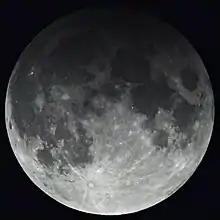| Partial eclipse | |||||||||||||
| Date | 25 June 1983 | ||||||||||||
|---|---|---|---|---|---|---|---|---|---|---|---|---|---|
| Gamma | −0.81520 | ||||||||||||
| Magnitude | 0.33479 | ||||||||||||
| Saros cycle | 139 (20 of 81) | ||||||||||||
| Partiality | 134 minutes, 36.3 seconds | ||||||||||||
| Penumbral | 314 minutes, 49.5 seconds | ||||||||||||
| |||||||||||||
A partial lunar eclipse took place on Saturday, June 25, 1983, the first of two lunar eclipses in 1983 with an umbral eclipse magnitude of 0.33479. A partial lunar eclipse happens when the Earth moves between the Sun and the Full Moon, but they are not precisely aligned. Only part of the Moon's visible surface moves into the dark part of the Earth's shadow. A partial lunar eclipse occurs when the Earth moves between the Sun and Moon but the three celestial bodies do not form a straight line in space. When that happens, a small part of the Moon's surface is covered by the darkest, central part of the Earth's shadow, called the umbra. The rest of the Moon is covered by the outer part of the Earth's shadow called the penumbra. The Earth's shadow on the moon was clearly visible in this eclipse, with 33% of the Moon in shadow; the partial eclipse lasted for 2 hours and 15 minutes.[1]
Visibility
It was completely visible over Australia, Pacific and the Americas.

Related lunar eclipses
Eclipses in 1983
- A total solar eclipse at the Moon's ascending node of the orbit on Saturday, June 11th, 1983.
- A partial lunar eclipse at the Moon's descending node of the orbit on Saturday, June 25th, 1983.
- An annular solar eclipse at the Moon's descending node of the orbit on Sunday, December 04th, 1983.
- A penumbral lunar eclipse at the Moon's ascending node of the orbit on Tuesday, December 20th, 1983.
Lunar year series
| Lunar eclipse series sets from 1980–1984 | ||||||||
|---|---|---|---|---|---|---|---|---|
| Descending node | Ascending node | |||||||
| Saros | Date Viewing |
Type Chart |
Gamma | Saros | Date Viewing |
Type Chart |
Gamma | |
| 109 | 1980 Jul 27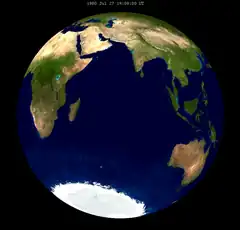 |
Penumbral |
1.41391 | 114 | 1981 Jan 20 |
Penumbral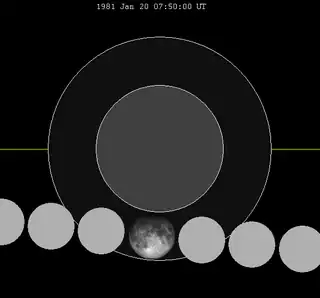 |
−1.01421 | |
| 119 | 1981 Jul 17 |
Partial |
0.70454 | 124 | 1982 Jan 09 |
Total |
−0.29158 | |
| 129 | 1982 Jul 06 |
Total |
−0.05792 | 134 | 1982 Dec 30 |
Total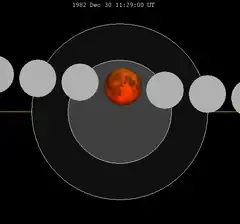 |
0.37579 | |
| 139 | 1983 Jun 25 |
Partial |
−0.81520 | 144 | 1983 Dec 20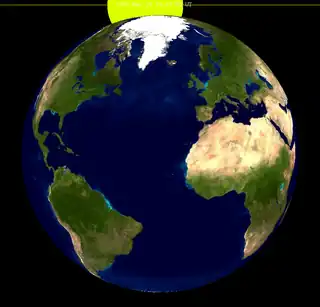 |
Penumbral |
1.07468 | |
| 149 | 1984 Jun 13 |
Penumbral |
−1.52403 | |||||
| Last set | 1980 Aug 26 | Last set | 1980 Mar 13 | |||||
| Next set | 1984 May 15 | Next set | 1984 Nov 08 | |||||
Half-Saros cycle
A lunar eclipse will be preceded and followed by solar eclipses by 9 years and 5.5 days (a half saros).[2] This lunar eclipse is related to two total solar eclipses of Solar Saros 146.
| June 20, 1974 | June 30, 1992 |
|---|---|
 |
 |
Saros cycle
Lunar Saros series 139, repeating every 18 years and 11 days, has a total of 79 lunar eclipse events including 42 umbral lunar eclipses (15 partial lunar eclipses and 27 total lunar eclipses)..
| Greatest | First | |||
|---|---|---|---|---|
The greatest eclipse of the series will occur on 2199 Nov 02, lasting 102 minutes.[3] |
Penumbral | Partial | Total | Central |
| 1658 Dec 09 | 1947 Jun 03 | 2073 Aug 17 | 2109 Sep 09 | |
| Last | ||||
| Central | Total | Partial | Penumbral | |
| 2488 Apr 26 | 2542 May 30 | 2686 Aug 25 | 3065 Apr 13 | |
| 1911 May 13 | 1929 May 23 | 1947 Jun 03 | |||
 |
 |
 |
 |
 |
 |
| 1965 Jun 14 | 1983 Jun 25 | 2001 Jul 05 | |||
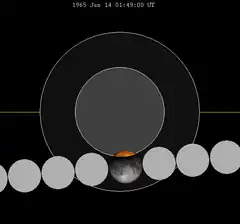 |
 |
 |
 |
 |
 |
| 2019 Jul 16 | 2037 Jul 27 | 2055 Aug 07 | |||
 |
 |
 |
 |
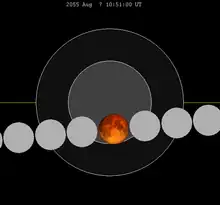 |
 |
| 2073 Aug 17 | 2091 Aug 29 | ||||
See also
Notes
- ↑ Hermit Eclipse: Saros cycle 139
- ↑ Mathematical Astronomy Morsels, Jean Meeus, p.110, Chapter 18, The half-saros
- ↑ Listing of Eclipses of cycle 139
External links
- 1983 Jun 25 chart Eclipse Predictions by Fred Espenak, NASA/GSFC
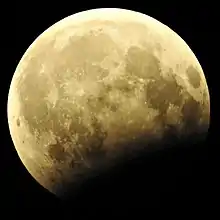
_(cropped).jpg.webp)
